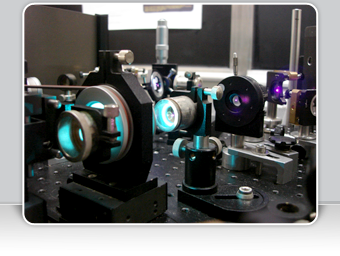Our various research interests are all related to ultrafast photochemistry and photophysics.
One reason to investigate photochemical processes taking place in ultrashort timescales, typically in less than a few tens of picoseconds, is that they may not obey the conventional rules of photochemistry.
Indeed the well-known Kasha's and Vavilov's rules stating that emission and photochemistry occur from the lowest excited states, namely S1 and T1 for closed shell species, and that their quantum yield do not depend on the excitation wavelength,
are based on the fact that internal conversion from upper excited states, vibrational and solvent relaxation are, in most cases, much faster than radiative transitions and photochemical processes.
However, if photochemistry occurs on a timescale similar to internal conversion from upper excited states, vibrational or solvent relaxation, these rules are no longer valid and the photochemistry may for example occur from upper excited states
or before the lowest excited state has reached thermal equilibrium. Therefore ultrafast photochemistry may open new possibilities, such as wavelength selective chemistry or reaction dynamics.
Photoinduced electron transfer reactions are particularly well suited to study such 'non-Kasha' photochemistry as they can take place in some cases within a few tens of femtoseconds. We are thus investigating the interplay between solvent and vibrational relaxation and electron transfer processes. Although photoinduced electron transfer reactions have been intensively investigated over the past four decades, there are still many unanswered questions. They concern for example the structure of the reaction intermediates (ion pair, exciplexes,...), the electron transfer distance, and the absence of inverted region for highly exergonic bimolecular photoinduced ET.
We are trying to answer some of these questions using various ultrafast spectroscopic techniques. This also implies the investigation of the photophysics of radical ions, which has essentially not been investigated so far.
Our present knowledge on the dynamics of vibrational relaxation in the condensed phase is presently insufficient for a controlled application of non-Kasha photochemistry. For this reason we are also investigating the dynamics of vibrational relaxation of molecules in the excited state.
Polar solvation dynamics is on the other hand much better understood. It is however not absolutely clear how the most used methods to investigate solvent motion, namely dynamic fluorescence Stokes shift and photon echo technique, are really equivalent. Moreover, we are also interested in the solvation dynamics of room temperature ionic liquids, which is much less.
Relaxation (vibrational and solvation) dynamics can also be used to probe the local environment in heterogeneous systems. We are thus studying the ultrafast excited-state dynamics of chromophores in the environment of biomolecules, such as proteins and DNA, and at liquid interfaces.
For all these investigations, we are using various optical spectroscopic techniques (transient absorption, fluorescence up-conversion, transient grating, photon echo, transient second-harmonic generation, ...) with a time resolution going from a few tens of femtoseconds to several nanoseconds. You can have here an overview of our labs.
Contact:
Eric Vauthey
Physical Chemistry Department - Sciences II - University of Geneva
30, Quai Ernest Ansermet - CH-1211 Geneva 4 (Switzerland)
© All rights reserved by Eric Vauthey and the University of Geneva
Design and code by Guillaume Duvanel

